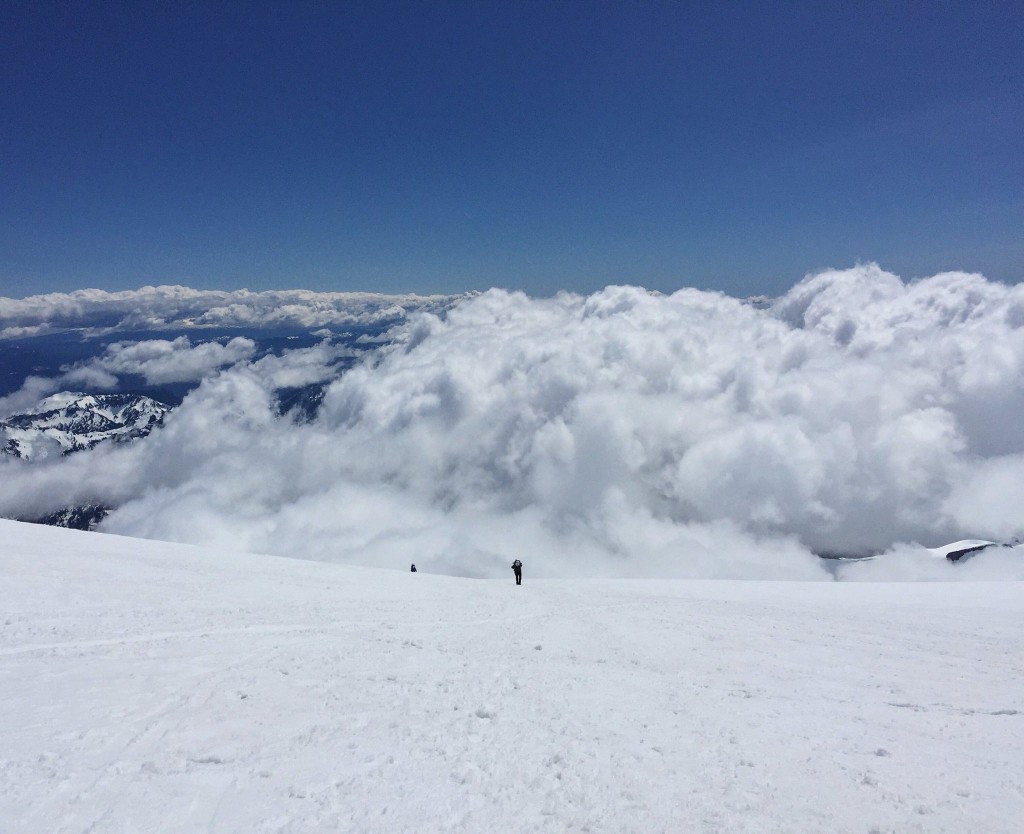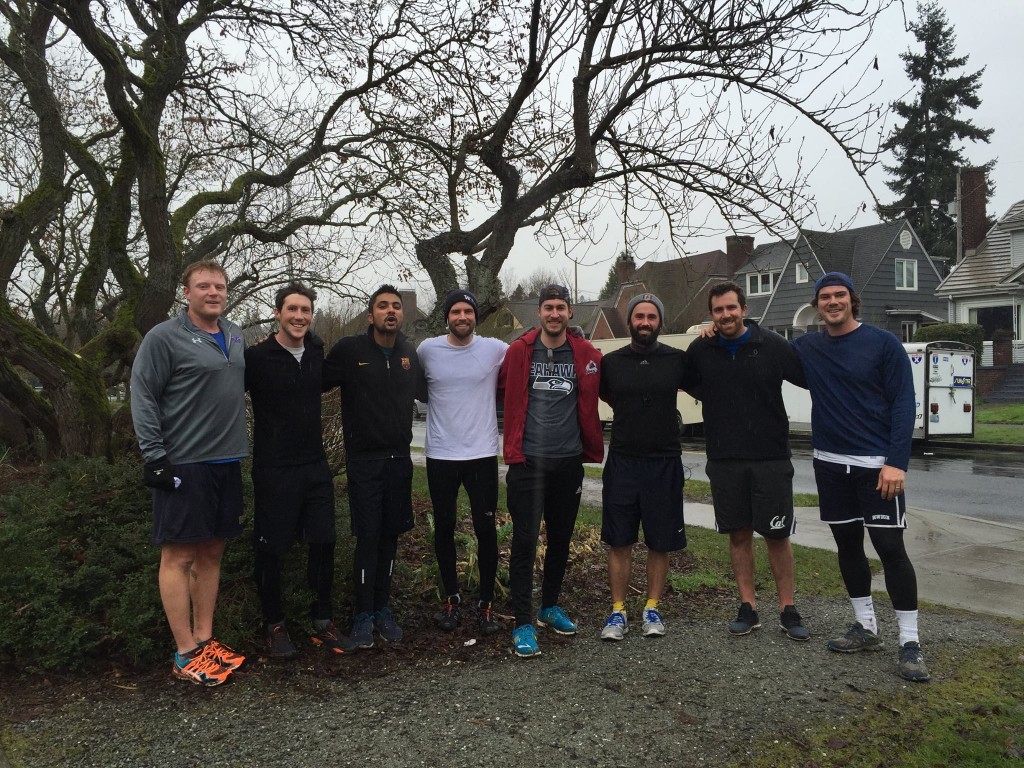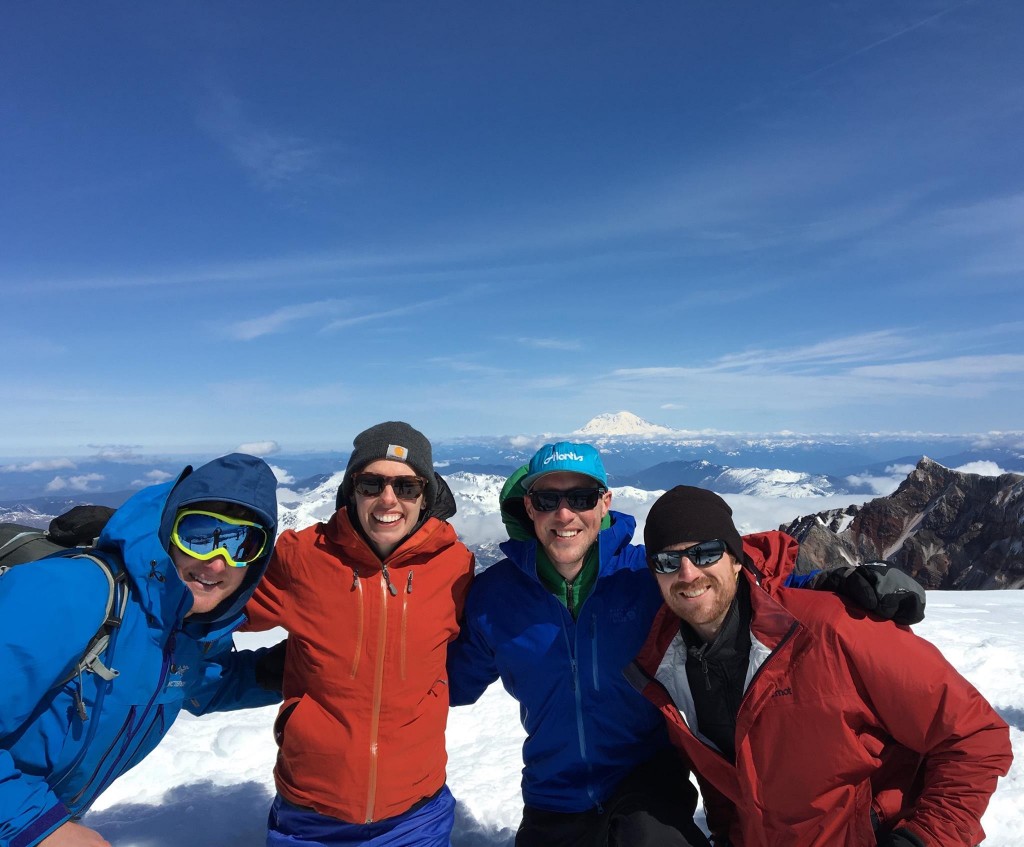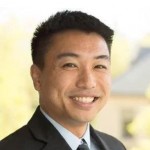The 2016 Challenge for Charity Rainier Climb
Sold on a conversation and a view
I still remember the time that I fell in love with the University of Washington. I had flown in on an impossibly sunny January day in 2014 to attend a “Preview Weekend” of the Foster MBA program with fellow admitted and prospective students, and the President of the Foster Veteran’s Association invited me out for a coffee chat. We discovered that we had both served at the same base in Afghanistan but had missed each other by a few weeks, and we ended up talking for almost 2 hours. After that great conversation, I was convinced. I decided to explore the area and eventually found myself at Drumheller Fountain at sunset, where I was met with the same awe-inspiring view that moved a century of UW students to become more than they thought they could be.
At the center of this view was Mount Rainier, the most prominent and heavily glaciated peak in the lower 48. The active stratovolcano rises over thirteen thousand feet from the surrounding terrain to a peak elevation of 14,416’ and its’ imposing mass can hardly be captured in photos. Imagine over nine Empire State Buildings built on top of each other with nothing else around it for hundreds of miles in any direction, and is so massive that it creates its own weather. I could hardly imagine what it was like to climb it, though I knew that many climbers attempted the summit every year with the help of paid guide services who did much of the heavy lifting. I also knew that two teams of Foster MBA students successfully reached the summit by themselves and raised over $13,000 for the Challenge for Charity in 2011 and 2012.
Seeing Mount Rainier in person put that achievement in perspective for me, and I knew that I wanted to help keep that tradition going. I wanted to be a part of a program that inspired its students to be audacious and take ownership of their experience. I immediately pulled out my checkbook and signed the deposit check that would confirm my attendance at the full-time MBA program at the University of Washington.
UW Mountaineering
The 2011 and 2012 MBA summit teams weren’t the only UW students to be inspired to climb higher. Several of America’s finest alpinists saw the same dramatic view of Mount Rainier from Drumheller Fountain and left to make their mark on the mountaineering world. Fred Beckey left UW with a degree in business and promptly became one of the most prolific climbers in North America, putting up numerous first ascents in the Pacific Northwest and beyond. During World War II, when the US Army needed to assemble a mountain assault force to evict Hitler’s soldiers from the Italian Alps, they called Beckey to help train them. Ed Viesturs arrived at UW as a Zoology student with dreams of someday climbing the great peaks of the world, and cut his chops on Rainier as a guide before becoming the first American to summit Everest without supplemental oxygen. Henry Landes (Prominent geologist, UW President and first president of The Mountaineers), Edmond Meany (Professor of Botany and History and the second president of The Mountaineers), Steve Swenson (class of ’77 and served as President of the American Alpine Club), Kitty Calhoun (MBA ’93 and founder of Exum Mountain Adventures)…the list goes on.

Field trip to Camp Muir on Rainier
Challenges
However, when I arrived at Foster in the Fall of 2014, the Foster MBA flag had not reached the top of Mount Rainier in several years. 2015 didn’t look very promising either, as the Pacific Northwest received a record low snow year, which threatened to create even more challenging conditions on Rainier. What separates Mount Rainier from other mountain peaks in the US is its dramatic prominence and glaciated terrain, which creates a set of dangers that aren’t found on other mountains of comparable elevation. Early in the season many crevasses (some of which are over 300 feet deep) are hidden underneath a layer of snow that softens under the sun. It’s not uncommon for people to cross bridges made of snow over these crevasses, and also not uncommon for people to fall through these bridges as the snow melts under the relentless summer sun. The melting snow also releases dangerous missiles of rock and ice, which can be heard thundering down the mountain at all times of the day. The mountain also creates its own weather, which threatens to turn a calm and clear summer day into a blender of fog and 100 mph wind gusts. Combined with the altitude, Mount Rainier turns back half of the people who attempt to attain its summit, and has killed even the most prepared and experienced teams. During Ed Viesturs’ time as a Rainier guide, he had turned his team around on a particularly icy day on the mountain and was heading back down when he saw another person attempting the summit alone. Viesturs cautioned the man to be careful and warned of the challenging conditions, to which the lone climber replied “It’s only Rainier.” The two continued on their separate ways, but shortly after, Viesturs watched in horror as the solo climber slipped and fell three thousand feet to his death.
2014 was also one of Mount Rainier’s deadliest years in recent memory. That summer, a six-person team of professional guides and seasoned clients attempted to achieve the summit of Rainier through a highly technical and challenging route known as Liberty Ridge. It’s not clear what happened next, but at some point the party was beset by severe weather and forced to set up camp on an exposed ridge. Several days later, a helicopter found the climbers’ GPS signals and gear from their campsite among avalanche debris several hundred feet from their last known location. All six climbers perished.
That same year, several Foster MBAs attempted to summit Rainier over two days but had to turn back. Weather conditions over the next year and a lack of motivation prevented an organized Foster MBA climb in 2015. However, the call of the mountain is relentless, and it wasn’t long before another Foster MBA team would form. A fresh year brought a new crop of MBAs who were eager to make their own mark on the program, led by Jason Matta (’17), an experienced mountaineer with five Rainier summits and a recent summit of Denali in his climbing resume. This time, we would return to the original intent of the annual climb: we would openly recruit for a team to attempt the summit to raise funds and awareness for charity.

Candidates for the Rainier climbing team training in the rain at Green Lake
The 2016 Attempt
It turns out that there was no shortage of Foster MBAs who were interested in joining the Rainier climbing team. We had former Olympians, ski patrollers, professional musicians, programmers, consultants, and more get involved in the training program. However, at the end of the five month program, only eight people self-selected to remain on the final roster. We wound up with an eclectic mix of veterans from the Army, Navy, and Air Force and civilians with backgrounds in professional sailing, international development, public relations, and law. The Foster MBAs who made it through the program had to sacrifice mornings and weekends for training hikes, team workouts, and field trips. Rather than study for exams or get precious hours of sleep, these team members woke up early to hit the gym or run laps around Green Lake. Instead of attending an important networking opportunity or practicing for case interviews, they went to the mountains to practice how to rescue an unconscious team member who had fallen into a crevasse.

Jason Matta (’17), Anna Bacheller (’17), Chris Burd (’17) and Andrew Rieck (’17) on top of Mt St Helens, great training for Rainier!
In addition to the substantial time commitment, there was a substantial financial burden from each climber. Everyone needed to help raise funds for charity, and they would also need to buy or rent all of their own gear for the climb. It’s still incredible that people would devote their scarce time and resources to be a part of this climb, and put their safety on the line to attempt to scale the mountain together.
As the training program came to an end, the team refocused their efforts on fundraising while simultaneously cramming for finals and the second-years on the team wrapped up their MBA experience. Thanks to the efforts of the team and for everyone in the MBA program, we successfully raised over $4,200 for Challenge for Charity. With the support of our friends, family, and classmates, we were ready and filled with purpose. Unfortunately, we had one climber who got sick the week of the climb, so only seven of us made the attempt. Finally, on June 4th, after many months of planning and preparation, we would be tested on Mount Rainier.
Here are the highlights from the attempt:
I still get teary-eyed thinking about the sunrise from the edge of Rainier’s crater rim. We had the entire place to ourselves, and proudly unfurled the Foster MBA banner at the tallest point in Washington. We now understood what it feels like to stand on top of Mount Rainier and look northward towards Seattle, towards Drumheller Fountain and those wide-eyed students who dreamt of someday climbing mountains of their own. It was the culmination of the team’s hard work over the last 6 months, but for me the feeling was bittersweet. As a second-year, this would mark the end of my Foster MBA experience.

From left to right: Nelson Tang (’16), Jason Matta (’17), Morgan Connelly (’16), Chris Burd (’17), Andrew Rieck (’17), Travis Vaughan (’16), Joe Dennis (’16). Photo Credit: Joe Dennis
The End of the MBA
Over the last 18 months, I’ve learned so much about myself and gained invaluable tools to understand and solve complex challenges. I’ve been tested by exams, take-home papers, and the alpine slopes of the Cascades. Foster gave me the freedom and the support to explore new careers and my peers challenged me to broaden my horizons. Most importantly, I’ve made some lifelong friends and connections that I had never thought I would find outside of the military.
I could not have had the same intensity of experience at another MBA program. Foster’s proximity to awe-inspiring outdoor experiences, sense of community, and program support are unmatched. Other MBA programs may offer more structured opportunities in outdoor leadership that include professional instructors and guide services (and a hefty price). However, I believe that experiences are more powerful when you rely on your own wits and the strength of your team, and when you own the consequences of your actions. Those experiences are truly life changing, and I’m glad to have found that experience after writing that deposit check at Drumheller Fountain. I got exactly what I was looking for out of the Foster MBA. For all the future Foster MBA candidates, I hope that you find what you’re looking for too.
About the Author
 Nelson Tang (Class of 2016) is an 8-year Air Force Veteran who will be starting a career in corporate finance at Intel in August 2016. In the meantime, he might be found exploring other mountains in the Pacific Northwest after Rainier ignited a love for the alpine environment.
Nelson Tang (Class of 2016) is an 8-year Air Force Veteran who will be starting a career in corporate finance at Intel in August 2016. In the meantime, he might be found exploring other mountains in the Pacific Northwest after Rainier ignited a love for the alpine environment.

